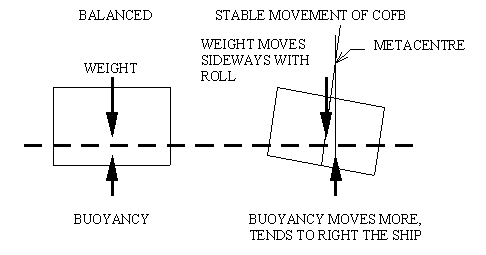
It's Not Very Complicated...Just Get In The Boat And Row
Think rowing is a relatively simple sport? Think again. (The following article on balance is copied from www.btinternet.com/~furnivall.sc/)
The article is in two parts: Part 1 follows the investigation in detail. Part 2 contains conclusions and a Q&A section. The less technically minded might want to skip Part 1 and go straight to Part 2, but I would recommend that if you are going to use this material you should read Part 1 to understand the reasoning and its limits.
Figure 1. Metacentric stability.
The equation defining the limit of stability of ships is:
Points to note about "metacentric stability":
The answer seems to be that we are not dealing with a rigid system.
The critical points about "punt stability" are:
Figure 2. "Punt Stability", a system with one degree of freedom.
CASE 2. Rigid crew off vertical. Classic ship analysis, roll over time.
Table 2. Sample section data for sections of 770 sqcm
Figure 3. Self-righting forces on V section moving hull.
Points about dynamic stability:
The oars in the gates are the other point of contact between the rower and the hull.
Points about oars and hand heights:
Points about skimming the water on the recovery:
Points about body inertia control:
| Mondego | Eight | Single | |
|---|---|---|---|
| Static stability | yes | no | no |
| Punt stability | yes | (yes) | no |
| Dynamic self-levelling | yes | yes | (yes) |
| Affected by oars | yes | yes | yes |
| Skimming recovery | yes | no | yes |
| Body inertia | yes | yes | yes |
Table 3. Hierarchy of control techniques workable in different boat types.
To summarise the main conclusions from Part 1 in no particular order:
Of course the crew have to (try and) fix any major disturbances in the boat as they arise.
And that's just balancing the boat! Why don't you check out the US rules of racing if you still don't think that rowing is a complicated sport. Or perhaps you may want to check out the physics of rowing.